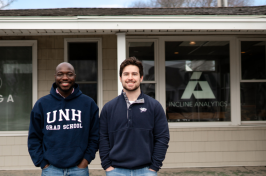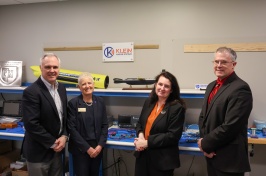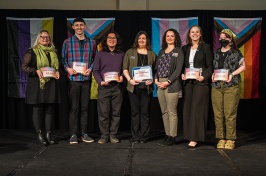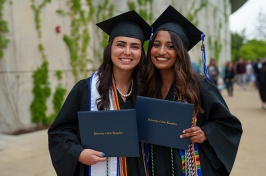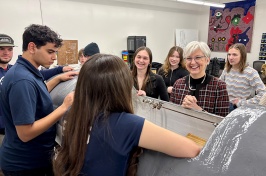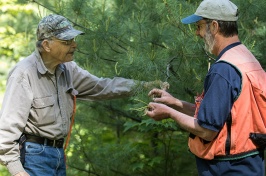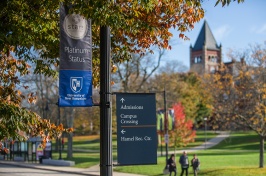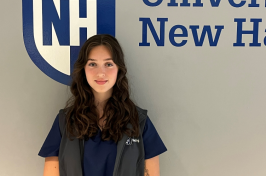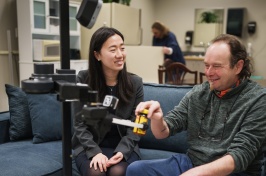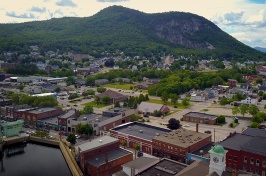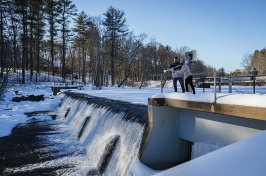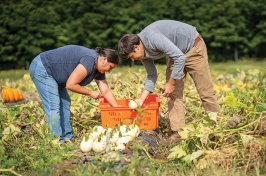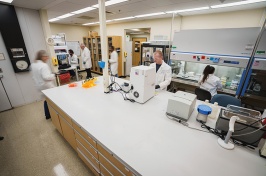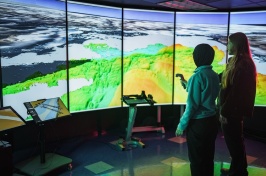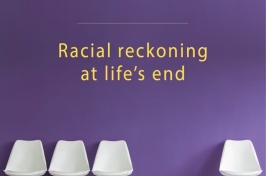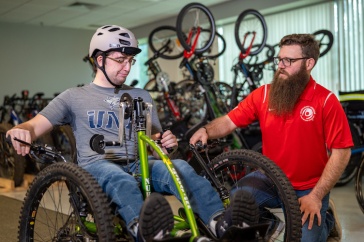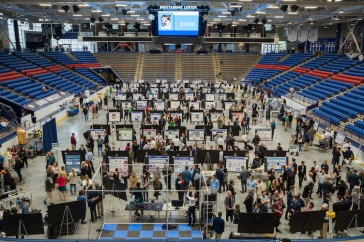The air is mercifully cool when they arrive at the excavation site outside the small Turkish village. The smells of ripening wheat, grazing sheep and the musky scent of earth greet the workers just after dawn. The wind, which will later swirl dust into their eyes and ears and upon their faces, is still as they begin to dig. Carefully, precisely, each of them--UNH history professor Gregory McMahon and his four UNH students--search for clues that will link them to civilizations dating back to 4,000 B.C.

FLINTY FELLOW: Turkish workers posing with a stone
version of a snowman, built with boulders pulled from the
Byzantine trench, are from left, Hasim, Selattin and Hayati.
Here on Cadir Hoeyuek, a mound that rises 100 feet, they will hunt for primitive pottery, bones and tools, foundations of homes, towns and temples--the remnants of people who lived here long ago. For five weeks, they will work with 14 other American and Canadian students, scholars and archaeologists, toiling 10-hour days in blistering sun and blinding dust, collecting, archiving and recording ancient treasures and trash left behind.
"It's one thing to study ancient history, but the thrill is getting out there," says T. Brice Pearce '09G, who is pursuing a master's degree in history. "The idea that you could be the first human being to see, touch or smell something that is 3,000 years old--it's almost like you've traveled back in time."
For McMahon, returning to the central Turkish village of Peyniryemez is equal parts reunion and homecoming. Since 1994, he has come to Cadir Hoeyuek to work with colleagues who share his passion for people and things long forgotten. "This is my calling, studying the past, other people's culture, by walking their ground, digging up their cities," he says. "The closer we can get to people in antiquity, the more we learn about modern society. Everything we do today--in our religion, our economy--is based on the origins of our civilization."

When McMahon first began working at the site, he hoped to find signs of the Hittites, a Late Bronze Age people who ruled Anatolia (ancient central Turkey) between 1,800 and 1,200 B.C. His search was rewarded: there were Hittites at the site, as evidenced by their pottery in several different places on the mound.

PIECED TOGETHER: A Late Chalcolithic (c.
3,000 B.C.) pitcher found at Cadir Hoeyuek.
The Hittite pottery, McMahon says, was likely used in ceremonies to worship ancient deities. Chariot-driving warriors, the Hittites cultivated wheat and barley and paid homage to multiple gods, who they believed ruled everything from fertility to the farmland and the thunder that rumbled in the sky.
"We think the mound was once an important cult or ceremonial site," says McMahon, who works as an assistant site director on the dig. "My real dream is to find written religious text or tablets explaining the rituals, or a temple's foundations."
Although they found Hittites, McMahon says they did not expect that "everybody else would also be there, beginning in the Chalcolithic period around 4,000 B.C., and continuing all the way to the middle of the Byzantine era in the 11th century A.D." Each successive civilization left a trail of unique pottery pieces in its wake--shards that are key to identifying people from the Stone, Bronze and Iron ages. Every year, other archaeologists come to the mound to compare their pottery finds to the shards unearthed by McMahon and his colleagues. "All archaeologists," acknowledges McMahon, "believe they are working at the most important site in the world." But because of the hoeyuek's continuous occupation, he says, "Anyone else in Central Turkey can match their pottery to ours to find out what time period they're looking at."

ENTRENCHED: The north side of Cadir Hoeyuek,
from the Iron Age trench to the Chalcolithic and
Early Bronze trench. Below, T. Brice Pearce '09G
takes notes.
After multiple plane flights and rides along rutted dirt roads, McMahon and his four students arrive in the remote village of Peyniryemez (Turkish for "one who does not eat cheese"). With the help of grants from the UNH Center for Humanities and the Loeb Foundation, McMahon and his students make their home in a Muslim community of 100 people, where families harvest fields of chickpeas, sugar beets and fragrant stalks of wheat. During the month of July and seven days in August, the field students slip into the cadence of working and living in a village far from their own cities and towns.
The day begins with the Ezan, or Muslim call to prayer, as the gray light slips from the sky. It is 4:30 a.m., and from a loudspeaker in the local mosque's minaret comes the cry Allah Akbar ("God is great"). McMahon and the students try to steal one more hour of sleep. By 6 a.m., they are on the mound, a 10-minute walk away, fortified with a breakfast of fresh yogurt, homemade bread, cheese and American coffee. The air is cool enough for sweatshirts and the wind has not yet begun to stir as they gather trowels, picks, shovels and brushes and head to their assigned trenches. Below the mound, a shepherd herds his sheep in the fields. The UNH students work side by side with local Turks who are hired to help dig on the site. Each morning, McMahon greets them with Guenaydin ("the day is bright") and shakes their hands, knowing that the morning ritual is expected and appreciated.
"Personal relationships are everything to the Turks," says McMahon, who speaks fluent Turkish. "They are a very polite and gracious people." While the students and Turks dig, they glean, through broken English and Turkish, fragments of one another's lives. "We do a lot of charades and hand-waving," says Pearce. At one point, the younger Turks challenge Orion Wellinghurst '09, a towering member of the UNH ski team, to a wrestling match, a invitation he respectfully declines.

The Turkish men are quiet around the women at the dig. Kaleigh Brooks '08, a history major and the sole woman among McMahon's field assistants, explains: "They believe that we are a little crazy to be working in the fields, getting filthy and doing physical labor."
As the weeks pass and July presses into August, the rhythm and rituals of Peyniryemez and Cadir Hoeyuek grow familiar. The students come to expect the calls to prayer, blared five times daily, the wind that stirs just after 11 a.m., and the constant digging, bending, measuring in 100-degree heat that leaves them utterly exhausted by 1 p.m.

HITTITE CAPITAL: History professor Gregory McMahon
takes students on a tour of Hattua. He's fluent in written
Hittite: 30,000 clay tablets found in Hattuša are the main
source of Hittite literature. Above, McMahon points to a
carving on the King's Gate.
This season, they do not find ceremonial tablets or a temple's foundation, but they do discover the lower half of a goddess made of lead from the middle Bronze Age, 1,000-year-old walls, a Byzantine ceramic oven that could have been part of a primitive community bakery, and a large stone block that may have been a manger or basin. They also unearth an abundance of pottery. Most of it is in shards, except for a spectacular find in the Chalcolithic trench, where they locate four identical cups that may have been made around 4,000-3,000 B.C. "Every time you stick your shovel in the ground, you find shards of pottery," McMahon says, "But it's very rare that you can recreate a total piece."
In the Byzantine trench, a millstone from the 11th century is unearthed. "It looks like a big flat stone with a circle carved into it," says Wellinghurst, who helped find the ancient tool. "It must have had a hand crank to grind the wheat."
Although this season's excavation did not reveal as many Hittite treasures as McMahon had hoped, it will provide new insight into the ancient mystery that pulls him back each year to Cadir Hoeyuek. "Archaeology is a cumulative process," McMahon says. "You uncover new parts of the puzzle every year. This year, we continued to excavate a large wall in the Byzantine trench. We're still trying to hypothesize what kind of building complex it could have been and what they used it for."
Regardless of the finds, McMahon relishes watching his students embrace life in a small Turkish village and the opportunity to learn how to search for and document primitive history. "They'll walk away with what I promised them," he says.

"They get to be part of a major archaeological team, living and working with scholars, seeing how they think and work," he adds. "And they get to experience a totally new culture, not just by visiting Turkey but by living among its people."
On a morning in August, McMahon and his students stow their luggage in a dusty blue minivan. A young village girl throws water onto their car, a Turkish tradition to ensure the visitors will return again. McMahon offers a Turkish good-bye given by departing friends: Allaha ismarladik ("We commend you to God.") The Turks reply with their own traditional farewell from those who are left behind: Guele. Guele. ("Go smilingly.") As McMahon leaves, he knows he will indeed return again to work with his colleagues, to revisit a village he has come to call home, and to dig for ancient treasures that lie beneath the dirt.~







